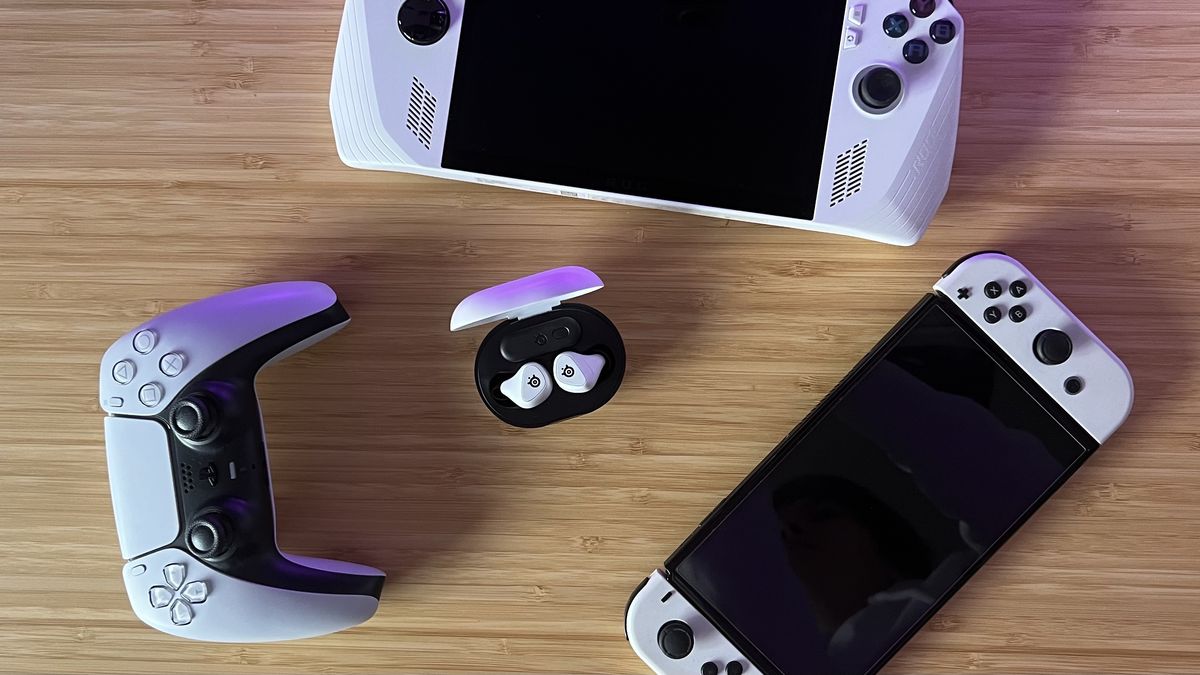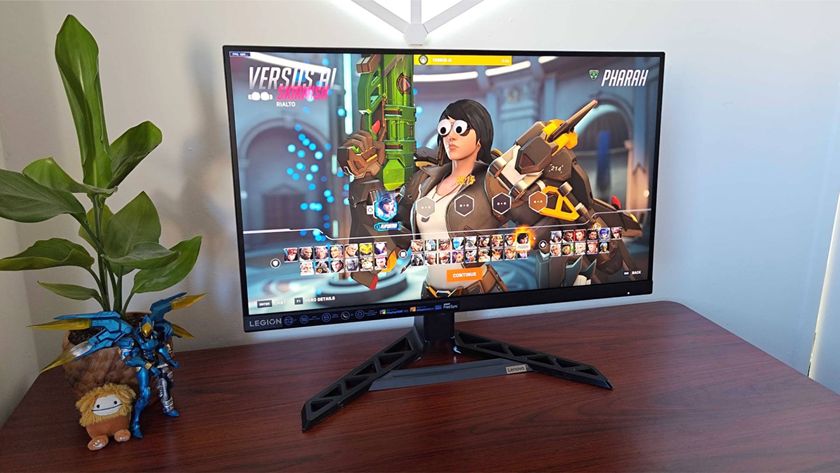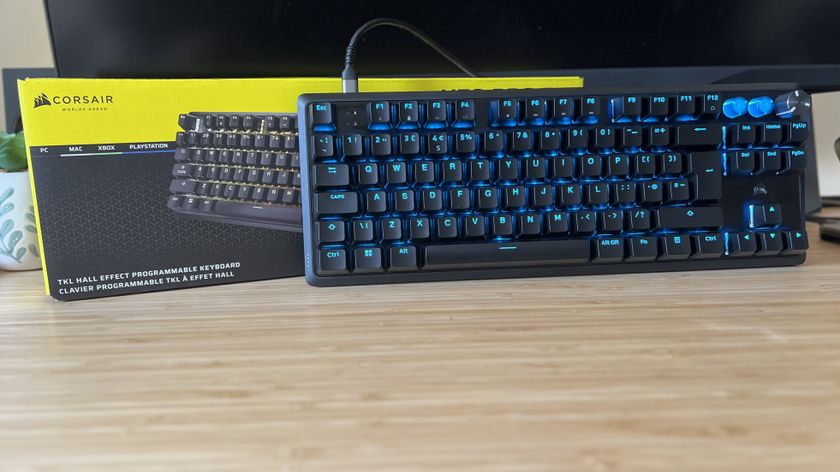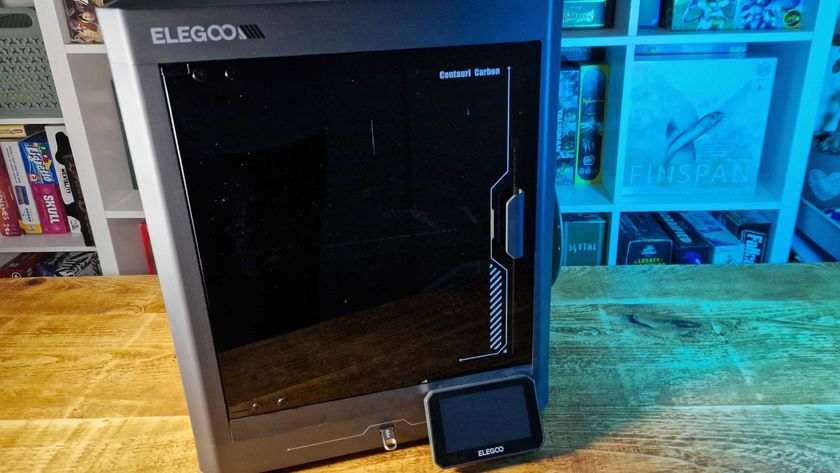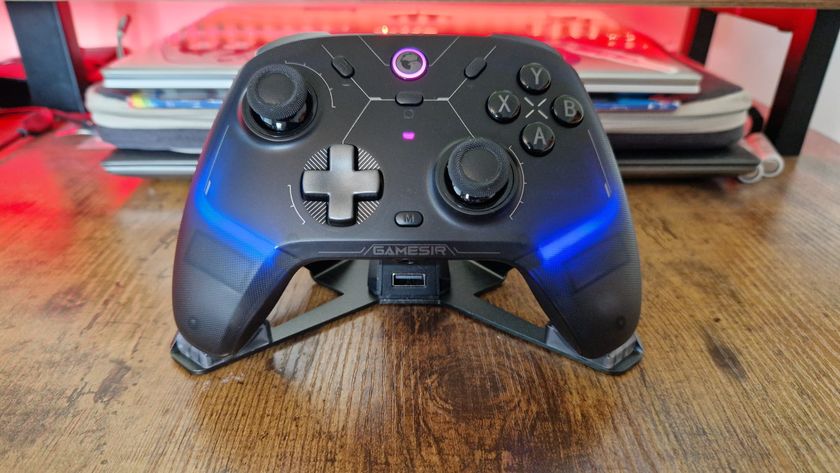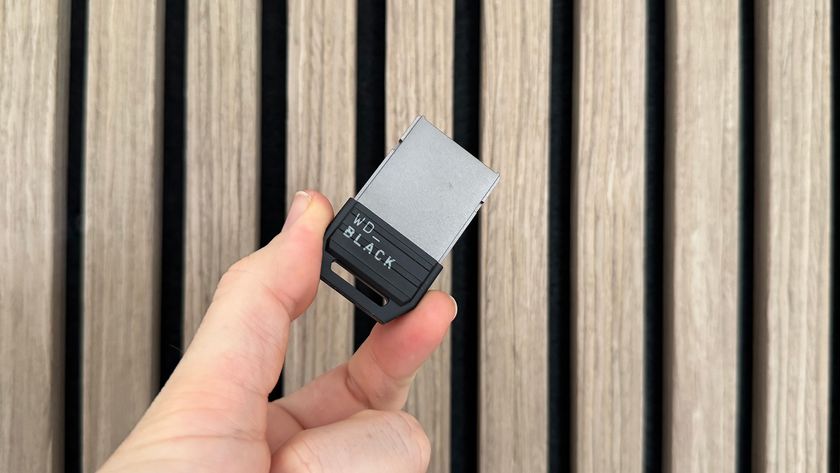12DOVE Verdict
The SteelSeries Arctis GameBuds are an incredible set of drivers, offering impressively wide audio with a rich texture and all the features you could ask for. Throw in the brand’s fantastic EQ app and a comfortable fit and you’ve got yourself the best buds in the business.
Pros
- +
Incredible audio
- +
Fantastic EQ preset software
- +
Button controls are far more reliable than the competition
- +
Long battery life
- +
Powerful ANC
Cons
- -
Wear detection can sometimes play up
Why you can trust 12DOVE
Think for a second, about what you would want from a set of gaming earbuds. Versatile but fast wireless connections? Powerful ANC? A long battery life? A wide range of EQ options? Now let me show you the SteelSeries Arctis GameBuds. They’re everything I’ve ever wanted from a set of gaming buds, and more.
The truth is, I’ve been waiting for this moment. This is the brand behind some of the best audio in gaming - its Arctis Nova Pro Wireless has topped the best gaming headset charts since release and even cheaper options beat others in their respective markets. I’m shocked that these in-ear drivers are the brand’s first stab at the world of the best gaming earbuds, it feels like SteelSeries has been making them all its life.
| Price | $159.99 / £159.99 |
| Connection | 2.4GHz / Bluetooth 5.3 |
| Drivers | 6mm neodymium |
| Frequency response | 20 - 20,000Hz |
| Microphone | Inbuilt |
| ANC | Yes |
| Controls | Tap gestures (volume, mic mute, ANC, connection toggle, call controls, playback) |
| Battery | 10 hours per charge (40 hours in case) |
| Weight | 5.3g per bud |
| Compatibility | PC, PlayStation, Nintendo Switch, mobile (Xbox version available), Meta Quest |
Design

I received both the white PlayStation and black Xbox versions of the SteelSeries GameBuds - both look great, but the white is just so much cleaner it has to be my favorite. Coated with a soft-touch matte finish, and stored inside a compact pill-style case, these buds feel every bit as premium as high-end mainstream offerings from Bose and Sony.
That SteelSeries logo, proudly stamped on the front of the clamshell case and across the large control button on each bud, is the only clue that these might be offering something more than your standard drivers.
SteelSeries has built these buds to last, with a sturdy outer shell to each side and IP55 water resistance making them viable options for both gameplay and everyday commutes. I’ve used the buds on numerous rainy dog walks, and they’re still as fresh as ever.
Every join is slick, and the charging / case detection contacts have stood the test of time, showing no signs of wear after constant daily use over the last three months. The case is just as sturdy, though the plastic shell feels a little thin around the top. It means this lid does creak a little when manipulated, but the hinge feels strong and snappy (a little too snappy until I discovered an extra notch to keep it open) and is neatly recessed into the design of the case as a whole. Unlike the Razer Hammerhead Hyperspeeds, there’s a neat little slot for the USB-C 2.4GHz receiver in here, keeping everything safe and tidy together.

A slightly bulbous form factor means each bud nestles neatly in the ear, with a plug-and-twist approach to ensure stability. They stay in my ear fairly well while out and about, only requiring the odd push back into position once in a blue moon, and feel more secure than Razer’s alternative overall.
Perhaps more importantly, they’re effortlessly comfortable. I lived through the dark ages of earbuds, regularly suffering from what we called ‘iPod ear’ back in the day. We’ve come a long way, and the soft edges of the Arctis GameBuds meld beautifully in the ear. They plug in neatly, with a reliable seal and lightweight feel. At just 5.3g each, and with a beautifully rounded design, they fade into the background incredibly quickly, and sit flush with the ear. They feature a similar stem-less design to the Cambridge Audio Melomania M100, but don’t stick out nearly as far and feel more secure as a result.
Features
These are some seriously stacked earbuds. We’re talking ANC, 2.4GHz and Bluetooth connections, a companion app with over 100 EQ presets baked in, 10 hours of battery life out of the case, Qi charging, transparency mode, in-ear sensors, and compatibility with every platform under the sun (provided you pick up the Xbox version). That’s the most robust feature set I’ve seen in a set of gaming earbuds, and it’s all available for an incredibly competitive price. You really can’t get much better than that.
I’ll kick things off with the most unique feature - something you won’t find in competitors’ arsenals. I first fell in love with the SteelSeries Arctis mobile app when the brand released the SteelSeries Arctis Nova 5 Wireless. At first glance, it’s your standard earbud software - providing access to battery levels and ANC controls. Open up that EQ menu, though, and you have one of the best collections of presets outside of the PC space. With over 170 options available, all designed by sound engineers, developers, or streamers, this is an incredibly inclusive roster of PS5, Nintendo Switch, PC, and Xbox titles. You’ll find dedicated presets for Apex Legends next to Baldur’s Gate 3, Genshin Impact rubs shoulders with Stray, and there are even dedicated audio profiles for Super Mario Odyssey and Terraria, with a list that’s growing all the time.

Of course, you’ve still got a range of more widely recognized EQ presets available, with settings for movie immersion and bass boost listed alongside these game-specific profiles. You can also set different profiles for 2.4GHz and Bluetooth connections. I tend to stick to Bluetooth for listening to music on my phone and keep 2.4GHz for gaming, so keeping the bass boost options on the former setting came in particularly handy. The app also goes into slightly more detail around mic settings than mainstream buds, with mic volume and sidetone sliders available on the main home screen.
One of my favorite features is the physical buttons on each bud, though. I’ve done my time with fancy swipe and touch gestures - and so far only Apple’s AirPods have proven to work reliably every time. I’ve been crying out for a full button, and SteelSeries’ implementation nails both basic and more sophisticated functionality. You’ve got full access to all media playback and call controls, with the options to remap single and double presses on each side to whatever function suits you. There are a lot of different functions to learn here, with different combinations of presses and holds registering different inputs. I generally stuck to basic media playback and mic muting which was easy enough to learn over the course of a few hours.

A wear sensor allows the GameBuds to detect when they’re being worn and continue playing your media, or pause when the buds are removed. This works well for the most part, though I did notice some false positives when carrying the buds loose in my pocket. Podcasts regularly continued playing in my pocket while I paused my listening.
That’s really the only frustration I encountered in my testing, the ANC is powerful for a set of buds and works to keep a range of frequencies clear from my listening. The battery life is also impressive - I was able to run these buds for well around two weeks of gameplay sessions and dog walks before needing to charge the case, and even then the Qi functionality means I just leave it on a charging pad. A 10-hour per bud charge meant I never dropped out of power during day-to-day usage either.
Performance

This is the smooth, velvety SteelSeries audio profile I’ve come to know and love from the brand’s over-ear products, stuffed into a pair of 6mm drivers. Despite their smaller stature, audio is still incredibly powerful, with a wide soundstage behind it and with plenty of room to breathe. That’s impressive, especially considering gaming earbuds often prioritize competitive use-cases, artificially boosting the lower mids and putting more tech in speed than driver design, ultimately falling short of textural sophistication. It’s why many opt to use slower but more dynamic mainstream buds from Sony, Bose, or Apple. The SteelSeries Arctis GameBuds offer the best of both worlds, and I haven’t touched my AirPods Pros since I took them out the case.
Whether it’s the cacophonous arenas of Doom Eternal or the sparse sound effects of Gone Home, the GameBuds bring a sense of breadth and detail that I’ve never heard from a set of gaming buds before. With the volume limiter and ANC switched off and the right game profile selected, these felt unlimited in their handling of everything from quieter moments to major cut-scenes, explosive action set pieces, and frantic firefights. I say switch that ANC off because, while it’s certainly helpful for music or podcasts on the road, it does apply a slightly woolly layer to the audio. Everything still sounds great, but if you’re already in a quieter environment there’s a more dynamic output without it.

Directional audio isn’t quite as precise as you’ll find from a larger set of drivers, and does sometimes sound a little blocky in fast-moving CS:2 moments. However, it presents a nicely immersive spatial sound that keeps up with surroundings in Spider-Man: Miles Morales’ Time to Rally mission sequence. Lower ranges are punchy and clear, with no distortion at higher volumes. There isn’t as much space between the clustered lows in Doom Eternal as you’ll find in a full set of SteelSeries Arctis Nova Pro Wireless headphones, but it’s still an impressively detailed experience considering the portable form factor. That detail is particularly well translated in The Last of Us Part 2’s claustrophobic The Descent mission. The echoes of debris and clickers have a crisp, clear presence against the dread-inducing rolls of the soundtrack underneath.
The smaller drivers do feel a little more restrictive compared to full headphones when it comes to the space these effects take up - they’re by no means flat but they can roll a little further in a larger headset. The same is true of Horizon: Forbidden West. Wider environments sound incredible, cut-scenes are rich and booming, and individual effects sound crisp and clean. Larger machine battles do sometimes suffer from blended audio, where all the individual machine sounds roll into one deeper whirr. It’s a tough test for any gaming headset, the only devices I’ve listened to that can push through have been particularly expensive. The Arctis GameBuds perform better in this test than any others in my pool, though.
Should you buy the SteelSeries Arctis GameBuds?

If you’re in the market for a set of earbuds that can see you through both gaming and everyday entertainment, there’s nothing better than the SteelSeries Arctis GameBuds at this $159.99 / £159.99 price point. In fact, I’m yet to test a more premium set of earbuds that manages to nail all the richness of this audio while still offering a faster 2.4GHz wireless connection. All platforms are catered for, as long as you pick up the dedicated Xbox version, and audio is well presented across the full range. Razer has its Hammerhead Hyperspeeds at the same price, but they’re harder to find on the shelves these days. Considering you’re picking up a more well-rounded audio, more comfortable bud shape, and all those EQ features, the switch to SteelSeries is a no-brainer.
| Comfort | ★★★★★ |
| Audio | ★★★★☆ |
| Battery | ★★★★★ |
| Microphone | ★★★★☆ |
| Versatility | ★★★★★ |
| Build quality | ★★★★★ |
How I tested the SteelSeries Arctis GameBuds
I’ve been using the SteelSeries Arctis GameBuds for the last two months, running them for all my daily dog walks, journeys, gameplay, music, and streaming. I’ve listened to more true crime podcast episodes than I care to mention and kept these buds hot for sessions in Fallout 4, Hogwarts Legacy, Final Fantasy XVI, and Assassin’s Creed: Odyssey. I also tested the GameBuds in each of our dedicated comparison games; The Last of Us Part 2, Horizon Forbidden West, Spider-Man: Miles Morales, Doom Eternal, and Counter Strike 2. For more information on how we test gaming headsets, check out the full 12DOVE Hardware Policy.
We’re also rounding up all the best wireless headsets on the market, as well as the best PS5 headsets and the best Xbox Series X headsets available.

Managing Editor of Hardware at 12DOVE, I originally landed in hardware at our sister site TechRadar before moving over to GamesRadar. In between, I've written for Tom’s Guide, Wireframe, The Indie Game Website and That Video Game Blog, covering everything from the PS5 launch to the Apple Pencil. Now, i'm focused on Nintendo Switch, gaming laptops (and the keyboards, headsets and mice that come with them), PS5, and trying to find the perfect projector.

WWE 2K25 MyRise walkthrough and chapter rewards guide

Tron: Ares fires up a brand new trailer and brings light cycles into the real world

Doctor Who showrunner Russell T Davies is manifesting DC star Viola Davis being the next iteration of the villainous Master, calling her "one of the greatest actors in the world"

